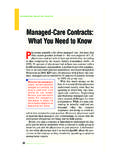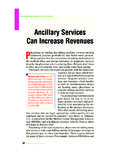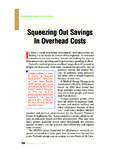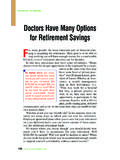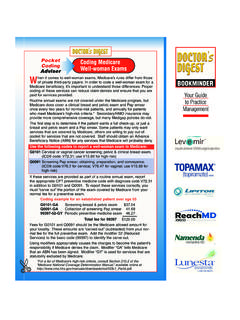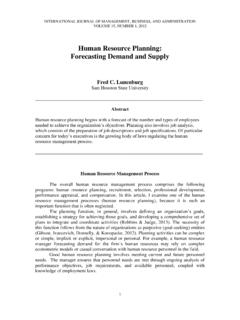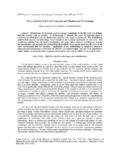Transcription of Budgeting and Forecasting - doctorsdigest.net
1 MANAGING YOUR PRACTICE'S MONEY. Budgeting and Forecasting Chapter FastFACTS. 1. It is essential for physicians to review monthly the practice's operations or income statement, balance sheet, and statement of cash flow. 2. Forecasting helps determine how many patients each physician needs to see each month to break even. 3. Benchmarking categories include median total revenue per full-time physician. 4. Successful practices don't have to achieve every industry benchmark or best practice. 5. MGMA data confirm that practices that pay close at- tention to basics, such as billing and collections, tend to fare better financially. I. n late 2010, when pediatrician Anne B. Francis, MD, looked at her practice's preliminary budget for 2011, she saw poten- tial trouble ahead. Revenue from office visits was likely to decline in January and February, when patients with high- deductible insurance plans typically forego discretionary visits to avoid paying out-of-pocket.
2 At the same time, the practice would face a 15% hike in health insurance costs for its own staff. Armed with these facts, Dr. Francis, one of eight pediatricians at Elmwood Pediatric Group in Rochester, , which employs about 50 people at two offices, instructed her staff to contact parents of new college students and kindergartners in order to schedule routine checkups during the anticipated slow months. 26 MANAGING YOUR PRACTICE'S MONEY. As a result, the practice avoided a potentially significant drop- off in revenue during the first few months of the year. You need to do some modeling and projecting in order to be prepared to deal with the consequences, says Dr. Francis, who is immedi- Many practices are still in the shoebox mentality. Particularly in smaller, rural practices, much of their revenue is just what's left over at the end of the month.. Terry McGeeney, MD, MBA. President and CEO. TransforMED. Leawood, Kan. ate past chair of the AAP's section on administration and prac- tice management.
3 If you don't measure it, you can't fix it.. That's widely accepted advice for most small businesses, which routinely engage in Budgeting and Forecasting . However, doing so is less common among primary care practices. With lit- tle time to focus on financial matters, physicians often don't know the details of their cash flow and have no plan in place to control expenses or increase revenue. Many practices are still in the shoebox mentality, says Dr. McGeeney at TransforMED. Particularly in smaller, rural practices, much of their revenue is just what's left over at the end of the month.. Understanding Cash Flow Projecting annual revenue for a small practice is fairly straightforward because most revenue comes from visits, says Robert Eidus, MD, a family practitioner at Cranford Family Practice in Cranford, Based on past yearly trends, he has been able to predict revenue for the coming year within $10,000. I look for whether there will be changes in reimbursement and look at my capacity in terms of how many additional patients I.
4 Can take on, he says. Patient volume is highly predictable I. know that we will grow by between 700 and 1,100 visits a year.. To predict expenses, Dr. Eidus keeps track of monthly fees, infrastructure costs, and staffing as well as determining whether 28 Budgeting AND Forecasting . he will need to invest in new equipment or initiatives. Dr. Eidus has been able to stay profitable by keeping close tabs on his revenue and expenses, but he may be the exception among small practices. Unfortunately, says Mr. Arend of Trans- forMED, many doctors in small practices know very little about the details of their cash flow. He recalls asking one physician about his payroll and having the physician answer, I don't know. My bookkeeper does all that.. While it's fine to hire outside parties to help with accounting, says Mr. Arend, it's essential for the physician to monitor finan- cial statements in order to spot potential problems, track progress, and plan for growth. He advises physicians to review the following reports on a regular basis: Monthly financial statements: Review the operations or income statement, balance sheet, and statement of cash flow.
5 Compare numbers with the previous month and your monthly budget in order to spot potential problems. The statement of cash flow may be the most important report to review, writes Mr. Arend on TransforMED's Website. It shows the sources and uses of cash and details the changes in the cash position.. Accounts receivable: This report shows the amount of all cur- rent and past-due balances summarized by aging categories (current or 30, 60, or 90-plus days past due). Review balances by customer in order to focus on problem accounts. Metrics reporting: TransforMED recommends that practices measure productivity and report certain metrics monthly for each provider in the practice. Metrics may include hours scheduled for patient visits, number of visits, or revenue gen- erated per provider. Compare these metrics on an hourly or per-patient basis to determine overall revenue generation. Non-provider metrics might include no-show rates, claims processed, referral completion rates, etc.
6 New Law Extends Federal Deposit Insurance Find out how you can use the new permanent status of a maximum $250,000 per depositor per bank in your financial planning. Read the details in the winter issue of Doctor's Digest-Money Matters at 29. MANAGING YOUR PRACTICE'S MONEY. Coding review: Each month, review CPT code distributions by provider monthly. Large variations among providers with similar patient morbidities could be a red flag, Mr. Arend notes. Also consider periodic self-audits, which involve peer- reviewing a sample set of charts from each provider for proper coding and documentation. MGMA consultant Mr. Milburn advises his small-practice clients to put together a month-by-month cash flow estimate. To do so, first calculate your total available cash each month by adding cash on hand at the beginning of the month to the amount you expect to collect, he explains. Then estimate your expenses and how much you will have to take out as salary to determine your cash at month's end.
7 It's a simple spreadsheet forecast that the physician ought to be doing, Mr. Milburn says. It tells you what you need in terms of initial cash investment and when you will need it. For more tips, see Keeping Track of Cash Flow: 15 Tips and Three Budget Process Essentials.. Forecasting If you know your expenses, it's fairly simple to project annual revenue, Mr. Milburn says. Using a simple 12-month spread- sheet, you can compare your monthly expenses with your expected revenue in order to estimate how much revenue you will need to bring in to produce a profit. Start by estimating how many patients you will see per day, per week, and per month; then multiply by the average charge and collections for an office visit. Next, build a lag report; this is an estimation of how long it will take you to collect the month's charges, Mr. Milburn says. For example, it might take several months to collect on billings made in the first month. Figure out what portion of that first month's cash is going to come in the first, second, third, and fourth months and what por- tion you are never going to collect, he explains (calculate using historical data on the average time between filing a claim and receiving payment from Medicare or private insurers).
8 Then build in a 10%-to-15% loss ratio for bills that go to collections. When you add up what you think you will collect every month, that's the cash you will have on hand.. Forecasting helps determine how many patients the physician 30 Budgeting AND Forecasting . Keeping Track of Cash Flow: 15 Tips Healthcare consultant Mr. La Penna recommends that practices go through the following checklist annually: 1. Spot-audit receivables posting, especially adjustments. 2. Check fee schedule and determine if it is still reasonable. 3. If using multiple fee schedules on the billing system, determine if they are current and complete. When were they last updated? (They should have been updated at year's end or at the beginning of the year.). 4. Spot-audit the accuracy of cash-handling policies at the front desk, along with mail payments, and for purchasing for accuracy. 5. Spot-audit payment and adjustment posting. 6. Assure that billing department staff attended at least one Medicare carrier in-service training and at least one other billing seminar of reputable quality as appropriate for your practice.
9 7. Assure that your manager is regularly attending classes ( , at a local college) or seminars geared to enhance his or her professional education and growth. 8. Verify that your billing staff have access to a network of other physi- cian offices that use the same billing software. Are they meeting with these people on a regular basis ( , at least quarterly)? 9. Review your insurance needs and their costs. It's important to com- parison-shop annually. 10. Review your accounting and legal needs and the service you have received at least every three years. Comparison-shop. 11. Verify that physicians are meeting regularly as a governance body, documenting those meetings with minutes and following up with accountable agendas. 12. Verify that physicians are meeting regularly (at least monthly) with management staff to keep staff apprised of changes in policy and pro- cedure, planned changes, etc. 13. Assure that patient satisfaction surveys are being conducted and reviewed and that changes are being made within the practice in response to concerns expressed.
10 14. Assure that employees' performance reviews have been conducted and documented annually. 15. Verify that medical records are being archived appropriately and in the most cost-effective and reasonably safe manner possible. 31. MANAGING YOUR PRACTICE'S MONEY. Three Budget-process Essentials A practice's budget should be its internal control tool, according to Fred Simmons, CEO of Clearwater Cardiovascular and Interventional Consult- ants, and Lee Ann Webster, practice administrator for Pathology Associ- ates of Alabama, on MGMA's blog. Knowing your actual and projected expenses can enable you spot errors and to protect your practice from fraud or embezzlement. Mr. Simmons and Ms. Webster recommend the following three budget- process essentials: Be disciplined and thoughtful. Think about how changes in reim- bursement, new services, and perhaps even new locations will affect your budget. Set a date when the budget will be complete and stick to it. Be realistic.
